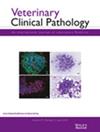Eosinophilic cavitary effusions in cats: 48 cases (2010–2020)
Abstract
Background
Eosinophilic effusions are commonly defined as effusions with ≥10% eosinophils. Eosinophilic cavitary effusions are infrequently observed in cats, with few case reports comprising the majority of the recent literature.
Objective
The objective was to review disease associations of cats with eosinophilic cavitary effusions and to assess if a lower threshold of eosinophils (5%–9%) may warrant consideration of similar etiologies associated with effusions with ≥10% eosinophils.
Methods
Cytology reports were retrospectively reviewed for all feline cavitary effusions submitted for fluid analysis from 2010 to 2020 at a veterinary teaching hospital. Cases were included if the manual leukocyte differential included ≥5% eosinophils and separated into 5%–9% and ≥10% eosinophils groups. Patient records were reviewed for associated medical conditions.
Results
A total of 669 effusions were submitted from 579 cats; 50 effusions from 48 cats had a leukocyte differential with ≥5% eosinophils. The eosinophil proportion was ≥10% in 22 cats; the most common underlying cause was neoplasia (10/22, 45%), followed by inflammatory disease (4/22, 18%), cardiac disease (3/22, 14%), suspect neoplasia (3/22, 14%), and undetermined (2/22, 9%). The underlying causes for the 26 cats with 5%–9% eosinophils were similar; neoplasia (8/26, 31%), cardiac disease (6/26, 23%), inflammatory disease (4/26, 15%), suspect neoplasia (3/26, 12%), undetermined (3/26, 12%), and idiopathic chylothorax (2/26, 8%). Cats with eosinophil proportions ≥10% in the fluid exhibited peripheral eosinophilia more frequently (35%) compared to those with 5%–9% eosinophils (5%).
Conclusions
Consistent with the current literature, neoplasia, particularly lymphoma, remains a primary consideration for cats with eosinophilic effusions. Previously unreported associated diseases included cardiovascular and inflammatory disorders. Our findings suggest an eosinophil differential of 5%–9% is seen with similar etiologies considered for classically defined eosinophilic effusions.


 求助内容:
求助内容: 应助结果提醒方式:
应助结果提醒方式:


